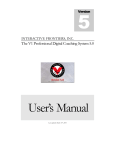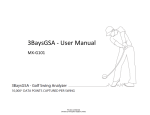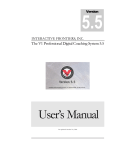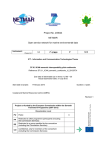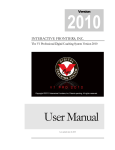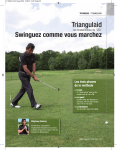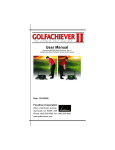Download Swing Setter Instruction Book
Transcript
Swing Setter Instruction Book 12/1/04 12:01 PM Page c1 SWING SETTER The Revolutionary Practice Tool For Great Golf Leadbetter, has made a significant contribution to the game of golf “ David through his teachings. He is now, more than ever before helping grow the game by making the introductory process less intimidating and is also contributing to the retention of those who have seriously considered giving it up. He is doing this by introducing a training device which in minutes exposes and teaches the very fundamentals of the golf swing. ” Frank Thomas President and Founder of Frankly Golf Technical Director USGA for 26 years Chief Technical Advisor to The Golf Channel and Golf Digest Instruction Manual Swing Setter Instruction Book 12/1/04 12:01 PM Page c2 Personal message from Dear Golfer: Thank you for purchasing the David Leadbetter SwingSetter. All of my years of teaching experience combined with months of testing and engineering, have gone into developing this innovative training tool. I am so excited about this unique product and know that with it, thousands of golfers will be able to improve their games, lower their handicaps, be less frustrated and have more fun. There has been an incredible buzz about this product. The golfers who have tested it early on have been flabbergasted by their improvement. I guarantee that your understanding, feedback and feel for the golf swing will improve incredibly with only a little practice. Follow my swing technique instruction on the enclosed DVD, and then with as little as 6 minutes, twice a week using the SwingSetter and following the included practice regimen, you will develop consistency, power, accuracy and tempo that you could only dream about. With just a little use of the SwingSetter it will provide you with that all important instinctive feel for a good golf swing, so that when you hit balls or go out and play on the course you will have a clear mind and swing with complete freedom. This is what the world’s best players do — fewer thoughts, more feel, better shots, lower scores. You will not be bogged down by over thinking. Believe me, I know - too much thinking causes tension, anxiety, poor rhythm and an inconsistent golf game. The SwingSetter will allow you to develop great technique without a ball - so often the ball inhibits our progress. Swing faults and compensations frequently occur as a result of a player trying to hit the ball solid and on line. The SwingSetter will give you the muscle memory necessary to build a powerful, consistent swing in literally just a few minutes a week. You’ll learn to hit the ball solidly and effortlessly with no mental stress. The SwingSetter is great for golfers of every level; it is simple, fun to use and becomes addicting to swing….and the best thing of all, you’ll get results!! Whatever your goals — learning to play the game, lowering your handicap, hitting it farther, curing your slice, improving your golf fitness level, teaching your kids the basics or simply improving your consistency — the SwingSetter will benefit all; it will be like having your own private instructor right in your home or office. Your friends will not believe you have not spent hours practicing or been taking lessons on the quiet. Enjoy the most versatile and complete golf training tool ever invented. The feedback you get from hearing, seeing and feeling the SwingSetter will instantly give you the secrets to improving your swing, increasing your power and accuracy and lowering those scores – even your short game will improve. I am firmly convinced that the SwingSetter will be the most talked about golf improvement tool for years. It doesn’t just fix one particular fault, it simply and quickly gets right to the heart of the swing – grip, plane, tempo and release – the key ingredients you need to play your very best golf. You’ll truly be amazed. So go to it. Best wishes and I hope that the SwingSetter provides you with the gift of great golf. W David Leadbetter PGA Professional — teacher to the world’s top players As a special note, I would like to offer special thanks to my good friend and long time student, Nick Price who truly believes the SwingSetter will help improve the overall standard of golf worldwide. Our accumulation of ideas and swing thoughts through the years has gone into producing this unique training tool. Swing Setter Instruction Book 12/1/04 12:01 PM Page 1 Plane Pointer Introduction to the SwingSetter Molded Grip The SwingSetter is a practice tool that I have personally developed and which is based on my swing teaching philosophy. We have tested hundreds of golfers from beginners to tour players before we were happy with the final product. The SwingSetter is a practice tool made up of 4 components that I know will help golfers of all levels to build and maintain a powerful, repeating golf swing. EZ See Club Face Adjustable Magnetic Balls With only a little practice you will develop a level of expertise that will make the golf swing thought-free and automatic. So, whether you have a little time to practice or a lot, you will see great improvement in your ball striking. With the SwingSetter you will utilize your three main sensory systems to improve your golf swing – visual, auditory and kinesthetic. You will see it, you will hear it and you will feel it. The SwingSetter is 36 inches long and weighs 20.5 ounces; it roughly weighs 50 percent more than your average five iron – just enough to really feel your swing. The four components of the SwingSetter are: 1. The perfect form molded grip that I designed in junction with the world’s leading grip manufacturer, Golf Pride will automatically place your hands on the club correctly every time. The innovative fins and outlines for the pinky fingers and thumbs ensure a great grip. I would estimate that 7580% of golfers who visit us at our academies, have bad grips from which stems numerous swing faults. 2. The plane pointer is an extension piece that extends from the end of the grip enabling the golfer to view their swing plane – an important factor in maintaining consistency. 1 Swing Setter Instruction Book 12/1/04 12:02 PM Page 2 3. The EZ See club face fits just beneath the grip allowing the golfer, because of its proximity to the hands, to easily see the face position throughout the swing and can also be used on a conventional golf club. 4. The two adjustable magnetic resistant balls are designed to promote correct wrist setting or cocking on the backswing and a proper timed release of the golf club at impact. Hearing the snapping of the balls will develop leverage in the swing so that you can accelerate the club aggressively through impact. Using the SwingSetter will not only increase clubhead speed, but by listening for the magnetic balls to snap, it will dramatically improve your tempo – a key factor in a good golf swing. *As an added benefit, utilizing the SwingSetter practice regimen will strengthen and lengthen your golf specific muscles – a fun way to keep fit for golf. Setting the resistance on the magnetic resistance balls The two magnetic balls have five resistance settings on each that are designed to accommodate differences in players’ physical strength and also swing tempo. Setting 1 has the least magnetic resistance while setting 5 is the strongest setting with the most magnetic resistance. The upper ball is involved in setting the wrists on the backswing (and finding the right tempo to do so) and Setting 1 Setting 5 is the least is the highest has less magnetic force overall than does the resistance resistance lower ball to account for the slower swing speed of the backswing. The lower ball has much stronger magnets in order to accommodate the extra speed on the downswing. The goal is to eventually be able to snap the bottom ball at the highest resistance (5). A tip to find your natural tempo is to swing your own 5-iron smoothly a few times, then pick up the SwingSetter and make a similar swing. I suggest while experimenting that you put the top ball on resistance level 1 to start with and the lower ball on 2 or 3, and work from there. Swing the SwingSetter at your normal tempo and get the upper ball to release on the backswing by the time you are halfway back; this is where your left arm is parallel to the ground. Extend the plane pointer prior to swinging, and check to see that at the halfway 2 Swing Setter Instruction Book 12/1/04 12:02 PM Page 3 SWINGSETTER TARGET LINE TOE LINE back position the plane pointer is aimed down to the ground at a point just outside your toes inside the target line. It is possible with a violent backswing that you could snap both balls as you approach the top of the swing, but this is obviously incorrect technique. The upper ball must snap prior to reaching the 1/2 way back slot – check the position and hold it for a couple of seconds allowing the magnetic ball to reset and you are ready to swing again. A late snap of the ball near the top of the backswing should be avoided. It results in many swing errors – poor wrist cock, At the halfway back position the over-swinging, no power, being off plane, etc. plane pointer points at the ground Swinging back smoothly and setting the wrist between the toeline and target line. angle properly is the key to leverage and solid contact. If you are snapping the ball late or not it is possible that there may need to be more of an aggressive setting of the wrists – made easier by a good grip, which you will now have. Your tempo may have to be sped up to accomplish the snapping on the backswing as some people, believe it or not, actually swing back too slowly (particularly ladies). Check the guidelines for resistance levels on page 4. A tip to get the correct wrist action and hear the snap is to start the backswing from a position slightly forward of where the ball would be positioned and use your stomach or abdominal muscles to help get the SwingSetter moving away. Moving the core stomach muscles in conjunction with the hands and arms provides momentum to the SwingSetter. The beauty of the SwingSetter is that you can find your right tempo going back and also over time, work on increasing your acceleration through impact by slowly raising the resistance levels. Do’s ■ Have a focus point. Place a ball or a coin on the ground to focus on (an extension from the SwingSetter would pass through the ball or coin). ■ Swing back smoothly. Find the resistance setting where the upper ball snaps when you move into the halfway back position where your left arm is parallel to the ground. In this position the plane pointer will be pointing at the ground just outside the toes and inside the target line. 3 Swing Setter Instruction Book 12/1/04 12:02 PM Page 4 ■ Make sure you hear the upper ball snap prior to the halfway back position and both balls snap again at the bottom of the swing in the impact area. ■ Close your eyes and swing to make sure you are aware of exactly where the balls are snapping. ■ Start off with a low resistance setting on the magnetic balls, and slowly increase it – especially the bottom ball. ■ Keep a note of the resistance numbers you have your SwingSetter set on in case other golfers change your personal setting. ■ Focus on good swing technique and holding your finish position. ■ On completing the swing, simply hold the SwingSetter up in front of you to get both balls to reset and you are ready to swing again. Don’ts ■ Try to over wind the setting. Do not attempt to turn the setting past number 5. ■ Hit the ground with the SwingSetter as you swing through. It may damage the SwingSetter or cause injury. ■ Swing in a confined area; you need plenty of room. ■ Start off on a setting that is too high. ■ Hear the upper ball snap late on the backswing (just before halfway back is ideal). ■ Hear the balls snap early on the downswing - the all important impact area is where you need to hear the sound. General guidelines for setting the initial resistance levels on the SwingSetter Upper Ball Setting Lower Ball Setting Ladies, seniors, juniors, beginners Current Distance: 7 iron ± 100 yards; driver ± 200 yards 1 or 2 1 or 2 Amateurs – slicers with smooth swings Current Distance: 7 iron ± 130 yards; driver ± 240 yards 1, 2, 3 2 or 3 Aggressive swingers, low handicaps Current Distance: 7 iron, 150 yards+; driver, 260 yards+ 3 or 4 4 or 5 Physically strong with high swing speed Current Distance: 7 iron ± 170 yards, driver ± 280 yards 3, 4, 5 5 Slow tempo, good player, high swing speed Current Distance: 7 iron ± 160 yards; driver ± 270 yards 2 or 3 4 or 5 4 Swing Setter Instruction Book 12/1/04 12:02 PM Page 5 SWINGSETTER Trouble shooting ■ If you find it difficult to get the upper magnetic ball snapping just prior to halfway back or the lower magnetic ball snapping in the impact area, reduce the resistance setting one level at a time until you achieve the desired result. ■ If you find there is no snap on the backswing and both balls snap on the downswing, reduce the tension on the upper ball (and or) try to increase the speed of your swing tempo on the backswing emphasizing the movement of the stomach muscles and the setting of the wrists. ■ If both balls snap in the backswing, increase the tension on the lower ball and slow your swing tempo. SwingSetter Drills *Note: The drills and program are explained in detail in the enclosed DVD. On pages 9 and 10, you will find the recommended swing drills to be used with the SwingSetter in the 6 minute training program (page 11). Prior to working on the drills, the following warm up and preparation exercises are recommended. Posture: Place the SwingSetter vertically on the ground directly in front of you. Position your right hand on top – palm down. Place your left hand, palm down, on top of right hand. This positions the left shoulder higher than the right, demonstrating correct upper body tilt. Position your feet no wider than shoulder width apart (instep to instep) and flex your knees slightly. Apply downward pressure to the club on the ground, feeling slight tension in feet, thighs and abdominal area as you bend from the hips while maintaining a flat lower back. You need to adopt the same body position when holding the Posture Drill SwingSetter in a regular address position. Relax the neck muscles and jaw. Your body is now in perfect athletic posture from where you are ready to move. *While doing the warm-up exercises and drills it is advisable to place a golf ball or small object such as a coin on the ground as a focus point. When holding the SwingSetter (as if making a practice swing with a 5-iron), the lower, fixed ball will be elevated a few inches off the ground; an extension of the SwingSetter would touch this coin or golf ball. 5 Swing Setter Instruction Book 12/1/04 12:02 PM Page 6 Pivot Drill Sequence Pivot: While maintaining your posture, take hold of the SwingSetter. Position it between the thumb and forefinger of each hand with the grip pointed towards the target. Fold the arms across your chest. Observe that the left shoulder is higher than the right. Focus on the ball or coin, which should be positioned slightly in forward of the of middle of your feet as if you were hitting a 5 iron. Be aware of a square alignment where imaginary lines across your toes, knees, shoulders and eyes all run parallel to one another and parallel to the target line. Initiate the pivot with a slight shift of your hips to the right (about an inch or so) and turn your left shoulder under the chin while keeping the spine axis constant. Freely turn back behind the ball while keeping the flex in the right knee. After completing the turn back, in a flowing motion, initiate the movement forward with the left knee and hip, and with a slight weight shift continue to turn the right side of your body towards the target. Finish tall, balanced and up on the right toe. Perform each pivot motion separately starting each one from the address position. Feel the balance, the wind up and the flow. This exercise loosens the big muscles up and encourages the perfect body rotation back and through – a source of real power. Sense the same body movement when you start swinging the SwingSetter. 6 Swing Setter Instruction Book 12/1/04 12:02 PM Page 7 SWINGSETTER Grip: Hold the SwingSetter up at a 45 degree angle with the right hand and the Leadbetter logo on top. Position left hand on the SwingSetter grip securing the pinky finger of the left hand in the outlined area. Close the rest of the hand around the grip while fitting the fingers in Holding club at 45 degrees Completed grip between the fins. Place the thumbs of each hand in the designated outlined areas and link the hands together with either the conventional overlapping or interlocking grip. The left hand will probably feel more in the fingers than you are normally used to. This is correct and will allow the wrists to cock properly. Baseball Swish Procedure: Adopt correct posture. Maintain the angles of the body, and elevate the SwingSetter so the shaft is parallel to the ground. Swing the SwingSetter on a baseball (or horizontal) plane. As you swing back and set (or cock) the wrists and the magnetic ball snaps, the swing will feel short. Apply your learned golf pivot motion. Baseball Swish Swing the SwingSetter forward on the horizontal plane keeping the wrists well ahead of the SwingSetter and the right elbow tucked in. Snap the magnetic balls right in front of your chest while moving the right side of your body all the way through to the finish. Results: This exercise will give you a real sense of a powerful wrist action. By setting the wrists going back, holding the wrist or lag angle, coming through and then snapping the balls as late as possible in the impact area, you will create tremendous speed and generate a lot of power. This “late hit” position (as it is termed) is the one all long hitters get into. 7 Swing Setter Instruction Book 12/1/04 12:02 PM Page 8 Slow Motion Swing Shape Awareness *Swing slowly through all of the positions and make sure to hold the finish position. TARGET LINE Plane pointer aimed at the navel as the swing starts back. TOE LINE Procedure: Adopt a square, aligned posture. The EZ See club head should be at a 90 degree angle to the target line. Focus on a target ball or coin. Extend the plane pointer, and aim it slightly forward of the navel area. Ultra slowly, swing the SwingSetter away while initially keeping the plane pointer aimed at the belly button. Swing back to the halfway position – wrists fully set. The plane pointer will be on plane and pointing to the ground just beyond your toe line and inside the target line. Note the gradual opening and closing of the EZ See club face. Complete the turn to the top; the club will be approximately parallel to the target line and to be square, the EZ See clubface should lie on an angle that is parallel to the forearm. As you slowly swing down make sure the plane pointer remains on plane pointing approximately to your target line – holding the wrist angle. The club face gradually rotates back to a square position. The SwingSetter will be approaching the target ball or coin on plane from inside the target line. As you swing to impact the club face will continue to rotate, being square at impact (opposite the focus ball) and the plane pointer will be pointing just ahead of navel. Continue the swing. Just past the ball, the arms are fully extended and the plane pointer looks at the navel once again. The club then continues to swing around on the plane and then finally on to a full balanced finish with the left leg firm. Plane pointer looking to the ground just beyond the feet on the backswing. On the downswing the plane pointer points at or parallel to the target line. Results: This drill will give you an excellent overall feel and image for the path, plane and shape of your swing and an awareness of the club face position. Be sure to make the motion continuous from start to finish – swinging at approximately 25 percent of your normal swing speed. Do not attempt to try and snap the balls during this exercise. Your warm up is now complete, and you are ready to undertake the SwingSetter drills using the technique we have discussed. 8 Swing Setter Instruction Book 12/1/04 12:02 PM Page 9 SWINGSETTER Slow Motion Swing Shape Awareness vel Comfortable athletic setup, square alignment, relaxed and ready. Wrists fully cocked, left arm parallel to the ground with the legs and feet stable. Complete the backswing. Shoulders fully turned, club parallel to the target line, right knee flexed. Club on plane, wrist angle maintained. Club fully released, arms extended, club face closing. Full balanced finish up on the right toe, left leg firm. n . 9 Swing Setter Instruction Book 12/1/04 12:02 PM Page 10 Drill 1 – Start Forward / Swing Back Procedure: Grip the SwingSetter; extend plane pointer Adopt good posture and alignment with the EZ See club face square to the target. Start the SwingSetter forward a couple of feet of the target ball. With motion from your middle, swing the club back halfway to the “L” position formed between the Start Forward Swing Back arms and the SwingSetter (where your left arm is parallel to the ground) snapping the ball hold the position, check the plane, allow the balls to reset and repeat. This position should feel compact and is shorter than you would imagine. Results: Develops powerful loading action of the club through correct wrist action. Drill 2 – “L” to “L” Procedure: Grip the SwingSetter and extend the plane pointer. Adopt good posture and alignment. Focus on the ball. Swing back to halfway, snapping the upper ball and form the “L” position between the arms and the SwingSetter (left arm parallel to the ground). Without stopping, continue “L” to “L” Sequence through the swing and snap the balls through impact. Stop the swing halfway up on the left side of the body and form the mirror image “L” position to that of the backswing (where the right arm is parallel to the ground). Feel the body turning back and through as you form the “L’s”. Repeat. *Use a low resistance setting on the bottom ball. 10 Swing Setter Instruction Book 12/1/04 12:02 PM Page 11 SWINGSETTER Results: This exercise develops synchronization between the body and arms, awareness of setting the wrists back and resetting them through, and also a powerful, accelerated release. Drill 3 – Extend the Triangle Procedure: Grip the SwingSetter . Adopt good posture and alignment. Swing the SwingSetter to the top of the backswing – snapping the upper ball. Hold the top position for a count of three. Swing down snapping the balls just past impact with both arms fully extended with the plane pointer looking at the navel. Hold this position. Repeat. *Use a low setting (1 or 2) on the bottom ball. Results: Develops the feel for a complete backswing, the full release of the club head and full extension of the forearms past the ball as opposed to the “chicken wing” look so often seen. Extend the Triangle Drill 4 – Eyes Closed Swing Procedure: Grip the SwingSetter. Adopt good posture and alignment. Close your eyes, and make a rhythmical swing from start to finish – hold your finish position. Focus on hearing and feeling the snapping balls in both directions. Repeat. Results: Develops an instinctive feel and awareness for the whole golf swing while placing emphasis on setting the wrists and really accelerating the club through impact. The auditory snapping of the balls will promote a consistent and instinctive tempo – one that you will be able to repeat when hitting balls. Drill 5 – The Real Thing Procedure: Grip the SwingSetter. Adopt good posture and alignment. Focus on the ball. Make the swing as flowing as possible being aware of the snapping of the magnetic balls back and through – hold your finish position. Repeat. Results: Develops muscle memory to build a consistent, repeating swing. 11 Swing Setter Instruction Book 12/1/04 12:02 PM Page 12 SwingSetter Training Program (Minimum twice per week – Time: 6 minutes; 30 seconds) REGULAR WARM UP ■ Posture routine ■ Pivot – 6-10 reps ■ Grip routine ■ Baseball swish - 6-10 reps ■ SloMo 6-10 reps 30 second break DRILL 1 – Starting Forward / Swing Back 10 repetitions 30 second break DRILL 2 – “L” to “L” 10 repetitions 30 second break DRILL 3 – Extend the Triangle 10 repetitions 30 second break DRILL 4 – Eyes Closed 10 repetitions 30 second break DRILL 5 – The Real Thing 10 repetitions SHORT VERSION (Time: 2 minutes) BASEBALL SWISH – warm up 6-10 repetitions DRILL 1 10 repetitions DRILL 5 5-10 repetitions 12 Swing Setter Instruction Book 12/1/04 12:01 PM Page c3 SWINGSETTER Suggestions ■ Do the program a minimum of 2 times each week for consistency. Establish a regular set time in your schedule and do the program routinely. (There is no harm in doing this 6 minute program more frequently – your flexibility, strength and feel will all improve as a result). ■ Remember – quality not quantity is what is required (doing more than the 6 minute session is of no real added benefit) ■ Breathe as you do each repetition ■ Focus on doing repetitions with perfect form ■ Practice with a friend or observer to insure correctness – its more fun! ■ Make sure you have plenty of room to swing (Keep clear of the ceiling, furniture, the dog, etc!) ■ If you feel tired just stop ■ Remember, although this is no more tiring than hitting a number of balls, it is well advised that you check with a doctor before you enter into any exercise program. ■ Pick the SwingSetter up and swing it anytime (even for a few seconds) to establish and retain the feel for the swing – so have the SwingSetter lying handy. Advanced Drills (low handicapper) ■ Gripping the SwingSetter with the left hand only swing halfway back to halfway through to encourage release and correct rotation of the left forearm – allow the left arm to fold on the follow through (use a low setting on both balls). ■ Make a slow swing using the SwingSetter and stop 1/2 ways down to impact. Hold this position for a couple of seconds, check that the plane pointer is aiming at the ball target line with the wrists fully cocked. From here, turn the chest through aggressively snapping both balls and finish with your right shoulder all the way through. This emphasizes a strong body release (a feeling of the chest rotating hard), a natural uncocking of the wrists, and eliminates overactive, flippy hands – a no-no for good players (use a comfortable setting that allows both balls to snap). Please write or email us at: We’d love to hear of your progress and success. David Leadbetter Enterprises ChampionsGate 8390 ChampionsGate Blvd., Suite 108 ChampionsGate, FL 33896 www.SwingSetter.com For information on our instructional programs and other products in the David Leadbetter line of training aids, please visit www.davidleadbetter.com. Swing Setter Instruction Book 12/1/04 12:01 PM Page c4 David Leadbetter Enterprises ChampionsGate 8390 ChampionsGate Blvd., Suite 108 ChampionsGate, FL 33896 www.SwingSetter.com






















